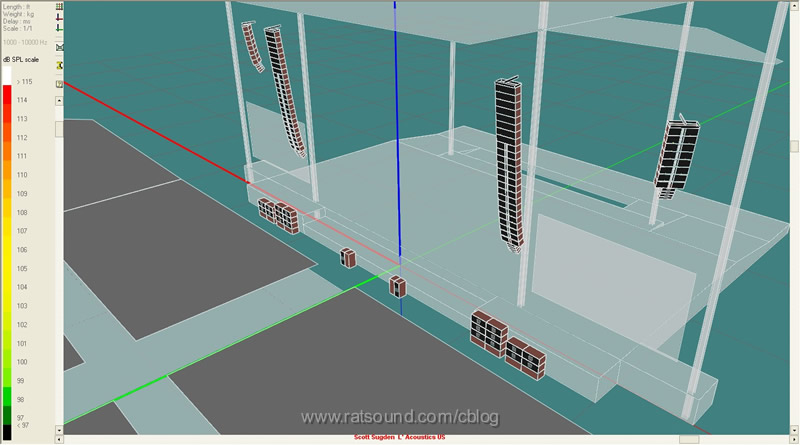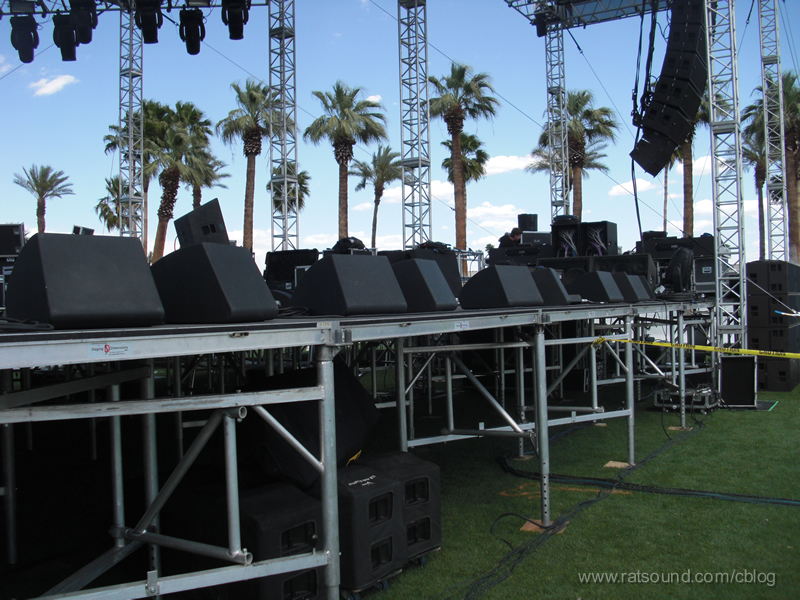Sound Porn
Ooooh, check out the sexy picture of main system for Coachella:

Here you can see the mains and side hang systems and also the 6 cluster subwoofer setup as well. There are quite a few new implementations of innovative theories in the design of the K1. The actual purpose and importance of the K1 Subs in the array is something that people are having a tough time getting their head around and I must admit that early on I was thinking "Why get any K1 Subs and not just buy more K1's, do we really need a third box type?" That was even further reinforced when I heard how much low end the K1 's can reproduce without any subs.
So what do these dual 15" boxes that are identical in size to K1 bring to the table and why do we need them or want them? Heck, for the most part, they are just K1 boxes with the mids and highs missing and I find their existence very interesting. In the mid 90's V-Dosc was new and the only large-scale line array on the market. Then, over the years nearly every major manufacturer has since staked their claim in the line-array bombardment of products. Each attempting some rehash and to add an asset to set themselves above the fray and to be honest, some really nice systems have come out of it by building upon the perceived starting point set by V-Dosc.
So taking a layman's look a line array theory, it basically says that the higher you stack up speakers the more control you can gain over the vertical coverage. With this vertical coverage control, you can do some interesting things like point more speakers far away and less speakers closer. This is cool because you can make it so that it is nearly the same volume far away as it is up close. Iimproving volume consistency throughout the listening area is a huge asset and we like huge assets.
In fact, a line array can be set up such that the volume level stays the same, even as you get farther away. Ahhh, but like everything in audio and life, obtaining something so desirable comes with a price to pay. Up to now line array designers have been addressing the entire audio spectrum with full range boxes plus subs. But the demands of the lower frequencies in the line array vary drastically from the demands of the higher frequencies. To put it in maybe something easier to visualize, the wavelength of the lowest notes we hear are about as long a one of those big rig tractor tailor trucks, including the motory part where the driver sits. The highest notes we humans hear have a wavelength maybe somewhere around the width of your thumb. Hmmm, how many thumb lengths to a big rig?
Anyway this vast differential in the wavelength creates many challenges. One of these challenges relates to the physical length a line array need to be to gain control over the various frequencies. Higher frequencies with short wavelengths only need a small vertical dimension while lower frequencies need an array of a much longer dimension. This is one of the fundamental reasons for the K1 sub. It allows the lower frequencies to have a longer line array length and and help match the coverage/throw of the lows to the mids and highs. Though this concept is natural and logical to line array design, it has been overlooked completely by all the line array emulations. But if the future follows the past, not for long as I am sure other companies will be soon to scramble to follow as it works way to amazingly well to ignore.
In fact the 'low throw' worked so well that we are rethinking the way we implement delay clusters. The natural absorption of HF by the air means sound will get duller with distance and so far, this means that for huge gigs the need to put up delay cluster is un avoidable, but since the K1 has the ability to present a clean tight controlled low end over much longer distances, the demand upon the delay clusters is reduced to only needing HF and perhaps a bit of mids. Running smaller, less obtrusive delays is a very cool thing cause we all know that setting up delay clusters is a pain, screws with sight lines and running low end into delays gets messy because it is so hard to control directivity. There is also another application for K1 subs as well but that will have to wait for a another day.
In the Sahara dance tent we set up mini sub cannons for the 2 side clusters and 2 rear clusters to get cardioid control and reduce bleed to other stages. This was the first year that we had no complaints about Sahara's sound stepping on the other stages. These are 1/4 wavelength at 50 hz spacing and time aligned for forward projection. Plus there is the added benefit of becoming a wonderful stacking surface for the V-Dosc. Say hey to Ronnie!

Not only was this the largest outlay of K1, ever in the world to this point in time, I also think it was the worlds largest outlay of EAW MicroWedge's with at least 50 or so. MicroWedge's did 4 of the 5 stages flawlessly!

So fun and more to come!
Â
Dave Rat
Comments
Display comments as Linear | Threaded
Brad Ferguson on :
Dave Rat on :
Kent Clasen on :
monitor man on :